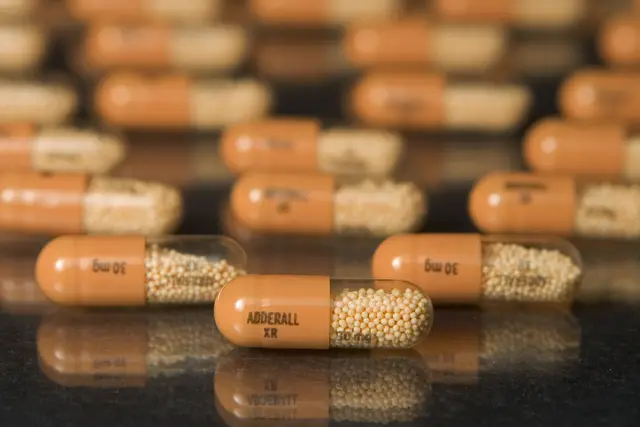Have you ever been to Enfield? I had never even heard of it until I was 23 and living in London for graduate school. One afternoon, I received notification that a package whose arrival I had been anticipating for days had been bogged down in customs and was now in a FedEx warehouse in Enfield, an unremarkable London suburb. I was outside my flat within minutes of receiving this news and on the train to Enfield within the hour, staring through the window at the gray sky. The package in question, sent from Los Angeles, contained my monthly supply of Adderall.
Adderall, the brand name for a mixture of amphetamine salts, is more strictly regulated in Britain than in the United States, where, the year before, in 2005, I became one of the millions of Americans to be prescribed a stimulant medication.
The train to Enfield was hardly the greatest extreme to which I would go during the decade I was entangled with Adderall. I would open other people’s medicine cabinets, root through trash cans where I had previously disposed of pills, write friends’ college essays for barter. Once, while living in New Hampshire, I skipped a day of work to drive three hours each way to the health clinic where my prescription was still on file. Never was I more resourceful or unswerving than when I was devising ways to secure more Adderall.
Taking Adderall without a prescription can cause seizures. Photo: Buzzfeed
Adderall is prescribed to treat Attention Deficit Hyperactivity Disorder, a neurobehavioral condition marked by inattention, hyperactivity and impulsivity that was first included in the D.S.M. in 1987 and predominantly seen in children. That condition, which has also been called Attention Deficit Disorder, has been increasingly diagnosed over recent decades: In the 1990s, an estimated 3 to 5 percent of school-age American children were believed to have A.D.H.D., according to the Centers for Disease Control and Prevention; by 2013, that figure was 11 percent. It continues to rise. And the increase in diagnoses has been followed by an increase in prescriptions. In 1990, 600,000 children were on stimulants, usually Ritalin, an older medication that often had to be taken multiple times a day. By 2013, 3.5 million children were on stimulants, and in many cases, the Ritalin had been replaced by Adderall, officially brought to market in 1996 as the new, upgraded choice for A.D.H.D. — more effective, longer lasting.
Capsule of Adderall Photo:dailynexus
Adderall’s very name reflects its makers’ hopes for an expanding customer base: “A.D.D. for all” is the phrase that inspired it, Alan Schwarz writes in his new book, “A.D.H.D. Nation.” And in fact, by the time I arrived at college in 2000, four years after Adderall hit the market, nearly five million prescriptions were written; in 2005, the year after I graduated, that number was just under nine million. By then, sales of A.D.H.D. medication in the United States totaled more than $2 billion.
By the mid-2000s, adults were the fastest-growing group receiving the drug. In 2012, roughly 16 million Adderall prescriptions were written for adults between ages 20 and 39, according to QuintilesIMS, an information-and-technology-services company that gathers health-care-related data. Adderall has now become ubiquitous on college campuses, widely taken by students both with and without a prescription. Black markets have sprung up at many, if not most, schools. In fact, according to a review published in 2012 in the journal Brain and Behavior, the off-label use of prescription stimulants had come to represent the second-most-common form of illicit drug use in college by 2004. Only marijuana was more popular.
We know very little about what Adderall does over years of use, in and out of college, throughout all the experiences that constitute early adulthood. To date, there is almost no research on the long-term effects on humans of using Adderall. In a sense, then, we are the walking experiment, those of us around my age who first got involved with this drug in high school or college when it was suddenly everywhere and then did not manage to get off it for years afterward — if we got off it at all. We are living out what it might mean, both psychologically and neurologically, to take a powerful drug we do not need over long stretches of time. Sometimes I think of us as Generation Adderall.
(New York Times)
 简体中文
简体中文





